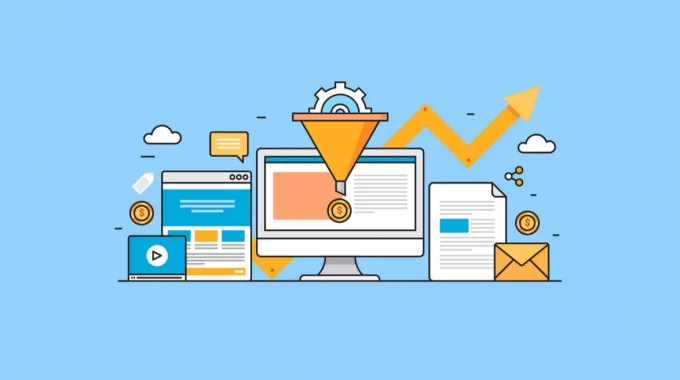The increasingly cutthroat digital purchasing market has certain guidelines which get people to buy from your company. These processes revolve around modification, which is arguably the most crucial measure to keep an eye on as you work to expand your company and boost sales.
The most useful eCommerce toolkits for companies to gauge investment return are conversion rates and the personalization that goes along with it (ROI). Your ROI can be considerably increased by boosting eCommerce conversion rates for determining how to improve a website properly.
A poll of US and UK marketers found that roughly 90% of undertakings on personalization yield a profitable return on investment.
But it's crucial to know that organizations should prioritize and, most crucially, enhance for them if they want to see conversions.
This is true whether you are merely getting started and managing everything yourself or if you are a marketing director or eCommerce manager committed to achieving significant targets and KPIs for the year. Let's begin with conversion explanations, frequently defined differently in businesses.
Comprehending Conversion Rates in E-Commerce
A website's conversion rate for eCommerce is the proportion of visitors purchasing from online stores.
For e-commerce websites, the following conversions are typical:
- Any KPI that your business considers useful
- Items added to a shopping basket
- signups for email
- Shares on social media.
- An online sale
- Items added to a wish list.
Because every element of your website's user experience has the potential to affect conversion, the subject is so vast.
Conversion rate optimization (CRO) promotes the shopping ordeal, which helps in increasing revenue.
Determining the conversion rate
If the online store has 8,000 visitors and 80 conversions in a specific period, the conversion rate is 1 percent.
It is frequently that easy, and the conversion rate is calculated by dividing conversion by the cumulative amount of visitors. Most analytics systems offer data segmentation conversion rates, which we'll discuss below.
To properly set up conversion rate standards for online stores, you must first understand what your present visitors are doing before attempting to boost eCommerce conversion rates. To gauge success, compare your benchmarks once you've identified them.
30 strategies to improve eCommerce conversion rates
1. Provide free delivery
Online buyers have developed certain expectations that they have come to expect from Amazon. Free shipping is a need in the marketplace of today. People will probably shop elsewhere if you don't offer free shipping.
Increasing product pricing to account for delivery expenses is an alternative to free shipping. But consumers are wise; if your costs are outrageous, they will go immediately.
2. Use excellent quality videos and images on pages
When you are shopping, consider what you desire to view. You cannot touch or try on a product when you shop online. The best action you can take to ensure that the buyer knows what they are purchasing is to display a particular photograph or video.
Users may more easily imagine what they are enthusiastic about, and a boost in eCommerce conversion rates can easily be done by using high-quality photographs and videos on the product pages.
3. Offer a momentary discount
Create discount codes or coupons that customers can utilize for a short period at the point of purchase to receive a certain amount or a portion of money off.
A sense of urgency will be created on the expiration of your coupon code, allowing customers to make purchases without interruption.
4. Offer affordable prices
If you want to compete, you must determine the price of your goods at or below the regular rate if you sell name-brand goods that are widely available in other retailers. Make careful to alter your prices to determine what works regularly.
The level of your marketing and visuals will also significantly impact how much someone is willing to pay. Sales will increase if you market your brand to the appropriate demographic using the proper messaging and visuals.
5. Examine and adjust the online store's checkout procedure
If your store's checkout procedure is too drawn-out, challenging, or unusual, you risk losing many clients just when they are about to make a purchase.
Several A/B tests and customization tactics should be conducted at this important funnel stage. Business norms exist for all eCommerce sites, but you must adjust the procedure based on the consumers to boost eCommerce conversion rates.
6. Make use of chatbots and live chat software
Customers can obtain answers to problems instantly without having to wait on hold for long periods through the phone by using live chat support software and chatbots to communicate with them.
Chatbots frequently replace the human component of live conversations. Therefore the two are commonly seen as alternatives to one another. The most successful businesses will probably combine chatbots and human elements to engage with clients after hours.
7. Use software to prevent shopping cart abandonment
Abandoned cart software can help you enhance your store conversion rates if you constantly deal with them.
This kind of software is provided for free as part of the shop functionality by some e-commerce platforms, like BigCommerce.
Every firm will experience this software's success differently, but there is no denying that it can benefit eCommerce stores that employ it.
8. Inform customers that your online store is secure
Companies want to swiftly establish trust for clients to be ready to give their credit card data on the website. Trust signals considerably enhance conversion, according to split testing.
The foundation of numerous conversion rate optimization efforts should be discovering new ways to improve your on-site reputation and trust.
Buyers expect to be sure they are doing business with an established company that uses industry-standard safety protocols. This guarantees the security of the credit card details given by them.
Several of the following are helpful:
- Install SSL wherever possible, ideally at the checkout (all eCommerce strategies have this feature by default).
- Display miniature representations of PayPal, credit cards, and different payment methods for visual cues to use trusted consumer payment choices.
- Show off your security badges like McAfee and GeoTrust to confirm that your account is still current. If you aren't completely secure, don't merely add a picture.
Read: Full Guide for Beginners for Image Optimization for Your eCommerce Website
9. Create an intuitive checkout form
Ensure all information on the checkout form—including information formats and CVV—is fully understood.
To simplify the process for users, try to restrict what could be entered in some form fields.
Format the credit card number when the user types it because it is easier not to mess up and read.
Don't allow users to fill in date fields; instead, provide a dropdown. Particularly considering that customers are frequently hesitant to provide their personal credit/debit card information, it is imperative to ensure you do not make consumers uncomfortable or make it hard for them to check out.
Digital wallets are a huge help in this. Payment gateways and applications like Amazon Pay, PayPal Express, and Apple pay are examples of digital wallets. Users can pre-fill everything with the information on account after signing in with these systems.
10. The website design should be simple for users to find products
By including options like "Shop By Color," "Shop by Product Type," and others, logically organize your product categories. Making as few steps as possible to get a user to a product as quickly as feasible should be the aim.
Your clients will notice a huge difference if you set up a rotating banner highlighting your best products and install a website search so visitors can find things quickly. It is vital to remember that the faster a visitor can find a product, the more likely they are to buy from you.
11. "Add to Cart" and "Checkout" buttons should be easier to find
An actionable button that clearly states what to do and sticks out from the rest of the text and visuals might further prompt users who are thinking about making a purchase.
As long as you're not obnoxiously hammering consumers with CTAs, marketers who overthink things are frequently to blame for the absence of these buttons.
To boost eCommerce conversion rates, BigCommerce now provides a customizable Buy Button that you can quickly add to your website.
12. Describe each product in great detail
Ensure to include a thorough description of the goods so that clients understand exactly what they are purchasing.
Keep in mind that they cannot handle the merchandise and cannot ask questions because they are not present in the store. Furthermore, doing so will aid in preventing returns.
A great addition to product descriptions is the inclusion of a demonstration or a product video.
13. Permit customers to pay as visitors
Assuming you already have the customer's name and email address from when they made the purchase, allow them to check out without creating an account.
By making them register, you give the customer another excuse to depart.
14. Shopping carts should always display the items
They can't check out if they can't locate their cart. When users add an item to their shopping cart, display a shopping cart icon with a link to it so they can return there and see their purchases.
15. Permit customer testimonials and product reviews
Why are there so many purchases made on Amazon or any big website? It is largely because of the availability of reviews on products.
Reviews from customers are essential in online buying—customer reviews signal to consumers and future clients regarding the legitimacy and performance of your company.
Obtaining favorable ratings to make or ruin your company. You can assist by providing customers with a promo or different incentives the following time they are purchasing in exchange for a review.
Furthermore, customer reviews of the product are a great selling point for firms based on services. Customers' testimonials about why they preferred your company and the advantages they experienced help promote your firm as a trusted source, boosting your eCommerce conversion rates.
16. Offer excellent product return terms
Before making a purchase, almost six out of every ten customers will study the retrieval policy. Make sure it is as simple and easy as possible for customers to return things, but be careful not to overpromise.
Although it might not seem like conversion optimization, this is another instance of standard business procedures serving as CRO. Gaining your customers' trust with an easy-to-return policy will help you boost eCommerce conversion rates and sales.
17. Make your phone number visible
A phone number on your website can assist calm the fears of your visitors. If something goes wrong, they will know they can always pick up the phone and call someone.
Adding a dash of authenticity can significantly improve your conversion rates.
18. Make your website mobile-friendly
Mobile commerce is anticipated to account for an additional 10% of total retail purchases in the US by 2025, up over 7% from the previous year.
You lose out on a sizable portion of purchases if your online store's mobile experience is subpar.
Hosted stores like BigCommerce support this, but you might need to adjust how it appears and functions on mobile for unique company requirements.
19. Offer informative material
Create useful content to go along with your items. Your customer is more likely to purchase from you if you can offer them more information.
Increase organic SEO traffic by creating content for the landing pages of your products and obtaining blog posts to enlighten, educate, and engage the audience.
20. Take down emails
It takes more than one visit for a visitor to convert. Therefore collecting email addresses is essential.
Offer a promo code after successfully collecting emails from pop-ups so that you can continue to market to them while they make a decision, sharply raising the conversion rates.
View the complete list of marketing integrations by one-click email offered by BigCommerce to boost eCommerce conversion rates.
Read: Why Social Media Marketing Is Beneficial for eCommerce Websites?
21. Quickly capture visitors' attention
You have a visitor's attention for a few seconds. If you can't keep them, then you've possibly lost them.
Photos of products are the first things someone will view and use to evaluate a website unconsciously. Make sure to choose wisely and work to attract visitors' attention if you plan to use large photos on the site.
22. Clearly state what makes you special. Why should a visitor purchase from you?
The reasons set you apart from the other businesses selling the exact products. What sets you apart from the competition? Why should I purchase from you?
Make jokes. Be wise. Otherwise, no one would choose to purchase with you instead of someone else.
23. Evaluate the success of your e-commerce optimization conversion rate
A few excellent techniques ensure that your adjustments and modifications are effective. Checking to see if the conversion rates are rising is the obvious one.
BigCommerce keeps track of your store's conversion rates daily, weekly, monthly, quarterly, and annual, as well as in any way you choose to watch. On the dashboard or the Analytics Dashboard, you can see this.
But you need to do more than simply boost eCommerce conversion rates; you also need to ensure that your bottom line or value per client is rising. Knowing what you'll do with the traffic you receive is more crucial than simply attempting to increase it.
Utilize what you currently have to the fullest before attempting to increase traffic.
24. Spell-check your written work
Poor formatting and misspelled words scream unprofessionalism. Make sure everything is spelled correctly.
Although it can seem like a small point, using formal language and spelling can present your company as a professional, knowledgeable enterprise. Sales may suffer if you don't accomplish this since consumers won't trust your business.
25. Implement a campaign to prevent browser abandonment
You can email your consumers while exploring your website but do not complete a purchase using a platform like Klaviyo.
You may give them coupons for items they were just considering buying or a polite reminder of the benefits of purchasing to take advantage of the offer.
26. Always do testing
Being continually testing A/B new concepts, from button shape or color and font size to complete page redesigns, is the best approach to increase conversion rates on your website.
Utilize free resources such as Google Optimize. You might require assistance with design and development by relying on the test.
27. Make sure your category pages have filters
Filters are essential for guiding your customers through the site and directing them to the appropriate products.
Create filters on your category pages for the various inquiries that your clients ask about the multiple products.
Let's say that the cost of your products is one of your clients' key deterrents. Then, by adding a price filter to the category page, you may remove their objection by just showing them things they can afford.
28. Be specific
There is no justification for not tailoring the user experience now that robust user tracking and communication software is readily available.
Your customer's path to purchase will be shortened by providing personalized experiences that boost your eCommerce conversion rates. You can maintain the user's attention on your message and the intended action across platforms by delivering personalized user experiences.
29. Implement checkout progress bars
Your consumers can track their progress through the checkout process and estimate how long it would take to obtain their transaction by including a progress bar.
You may encourage repeat business and a better customer experience by simplifying and improving the checkout method for customers.
30. Don't overuse calls to action
Avoid confusing users by placing too many options and CTA buttons on a single screen. Having all of your CTAs in the same spot, on the same page, whether they are for "Add to Wishlist," "Share Icons," "Add to Cart," or "Learn More," may prevent your sites from being overly cluttered.
Bring the user to the call to action button or action you want them to take on that page. "Add to Cart" should be used if they are on a product page. Use the 'Proceed to Checkout button if they are on the Cart page.
Conclusion
A well-designed website is essential for immediate and long-term success as online shopping becomes increasingly important in retail and e-commerce enterprises.
Businesses should place the highest importance to boost eCommerce conversion rates because they motivate consumers to do what is most crucial—purchase your goods.





